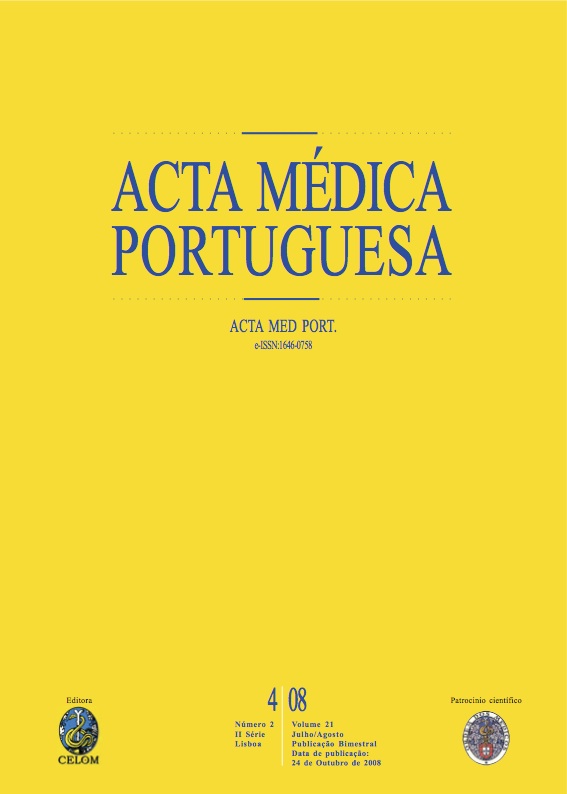Rastreio da perturbação de somatização nos cuidados primários de saúde - resultados de um estudo piloto.
DOI:
https://doi.org/10.20344/amp.801Resumo
There are no population based studies of Somatoform Disorders (SD) in Portugal, despite the fact that a high prevalence has been reported in other countries, mainly when less restrictive criteria are used for diagnosis. This study represents the first step to know the impact of this pathology in the community.To evaluate the psychometric properties of a Portuguese version of SOMS-2 (Screening for Somatoform Disorders) in primary health care (PHC) and studying its relationship with depression and anxiety. Method: All persons attending an urban PHC unit aged 18 years or more and knowing how to read and write were invited to participate in this study undertaken during 2 days in January, 2007. All participants filled a socio-demographic questionnaire and a translated version of a screening instrument for Somatization Disorder (SD) (SOMS-2), including a list of 53 somatic symptoms and 15 questions to evaluate the severity and presence of other somatoform disorders. A measure of anxiety and depression was also obtained using the Portuguese version of HADS (Hospital Anxiety and Depression Scale).The 122 participants, 16% out of the 760 contacted, had on average 46.5 years (sd = 16.3) and 63% were woman. After applying criteria for frequency (> 10%) and discriminative power in terms of incapacity, 19 symptoms were included in the final scale. Using as standard the number and the specific symptoms for the presence of Somatization Disorder from the DSM-IV-TR, a cut-off point of at least 8 symptoms was estimated. The sensitivity and specificity were 94.1% and 89.5%, respectively. This cut off warranted 22.1% of individuals to be referred for further examination. The relative risk of anxiety and depression in a somatizer were 3.4 (95%CI: 2 to 6) and 4.3 (95%CI: 1.6 to 11.6), respectively.The results obtained with this Portuguese version of the SOMS-2 including 19 symptoms indicate it might be helpful for the screening of SD in PHC, though further clinical validation will be needed for establishing differential diagnosis.Downloads
Downloads
Como Citar
Edição
Secção
Licença
Todos os artigos publicados na AMP são de acesso aberto e cumprem os requisitos das agências de financiamento ou instituições académicas. Relativamente à utilização por terceiros a AMP rege-se pelos termos da licença Creative Commons ‘Atribuição – Uso Não-Comercial – (CC-BY-NC)’.
É da responsabilidade do autor obter permissão para reproduzir figuras, tabelas, etc., de outras publicações. Após a aceitação de um artigo, os autores serão convidados a preencher uma “Declaração de Responsabilidade Autoral e Partilha de Direitos de Autor “(http://www.actamedicaportuguesa.com/info/AMP-NormasPublicacao.pdf) e a “Declaração de Potenciais Conflitos de Interesse” (http://www.icmje.org/conflicts-of-interest) do ICMJE. Será enviado um e-mail ao autor correspondente, confirmando a receção do manuscrito.
Após a publicação, os autores ficam autorizados a disponibilizar os seus artigos em repositórios das suas instituições de origem, desde que mencionem sempre onde foram publicados e de acordo com a licença Creative Commons









